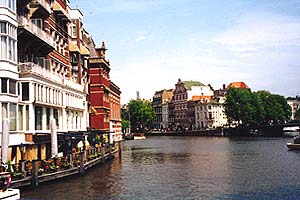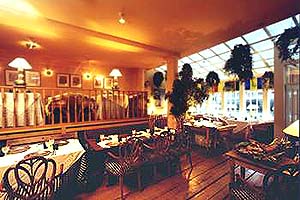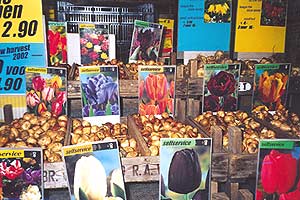by Dave DeWitt, Research and Notes by Mary Jane Wilan
|
Why Europe is Embracing Fiery-Foods Part Three: Amsterdam Part One Part Two |
Recipes: Spiced Coconut Beef (Rendang) Shrimp with Chile Paste (Udang Rica) Spicy Mixed Satays |
|
|
Amsterdam Canal Scene
|
I learned two things on the train to Amsterdam. First, the trains in Germany run mostly on time and stop for just one or two minutes at each station, so if you are switching trains you have to move fast. Second, that Germany has as much or more graffiti than the U.S. Most of it is very poor scribbling, but I did spot the entire side of a building painted to appear like a surreal living room. It was exceptional and I think that the term “wall art” is more appropriate for that work than “graffiti.” After a very pleasant ride we were at the Amsterdam train station and then in a taxi crossing canal after canal.
When Mary Jane had selected our hotel, she had focused on its location–the central section of old Amsterdam–and a reasonable price. Well, the Eden Hotel lived up to its name, and it was the second Eden we had visited in Europe. Our room was much larger than we expected, and nicely furnished. However, we weren’t going to spend much time in it.
The first order of business was to find some fiery-food, so we asked the concierge to suggest a good Indonesian restaurant, and he pulled a card for the Indrapura, and gave directions. It was just a few blocks away on Rembrandtplein (plein means “plaza”).
The Spice Islands Spice Back
Along our walk to Rembrandtplein we passed several coffee shops where the patrons, sitting outside, were sipping either coffee or beer and casually smoking joints or puffing on hashish pipes. Amsterdam is a very liberal city, we discovered, but we had other spices on our minds. The Indrapura turned out to be a beautifully furnished, medium-sized restaurant with teak-lined walls and attractive Indonesian-Dutch waitresses dressed in batik sarongs. We were asked if we had reservations, which, of course, we did not. But fortunately, we were there early, so we promised them we would be finished before the crowd arrived.
|
|
Interior of Indrapura Restaurant
|
We ordered some wine for Mary Jane, a dark beer for me, and some Indonesian-style egg rolls with a spicy chile sauce to dip them in. For our main courses, MJ tried the Beef Rendang, and I feasted on the Udang Rica, or spicy prawns. Both were excellent, with medium heat, and Peter ten Cate, one of the owners of Indrapura, provided recipes—see the end of the article. Mary Jane can never resist dessert, but at least she ordered one with spice in it–Indonesian Cinnamon Cake , topped with Cinnamon Ice Cream. I took a little taste and it was superb. By the time we finished dessert, the restaurant was full, with people waiting, so we took our leave of the charming establishment and walked off the dinner by wandering through the neighborhood.
The following day we had a lesson on why Indonesian restaurants are so popular in The Netherlands. We visited the Scheepvaartmuseum, or the Netherlands Maritime Museum and went on board the Amsterdam, a replica of a Dutch spice trading ship that was built from 1985 to 1990. The original was launched in 1749. It was an interesting experience for me because I had been on board a replica of the Batavia, an earlier spice ship that dated from 1628. (See my article detailing the Batavia in Australia). The improvements in 121 years of shipbuilding were remarkable. Not only was the Amsterdam considerably larger and more luxuriant, I could actually stand up in its cargo holds, which was impossible inside the Batavia. The originals of both vessels carried vast quantities of spices and other precious cargo from the Spice Islands, now Indonesia, back to The Netherlands.
|
|
Full-Size Replica of the Spice Ship Amsterdam
|
Indonesia was, of course, a Dutch colony, but the Dutch interest in the area dated back to 1595, when they began colonization. In 1602, they established the Dutch East India Company to exploit the riches of the region: nutmeg, cloves, mace, and later, black pepper. The Dutch domination of the archipelago lasted until 1949 when Indonesia achieved independence. During that long period of time, there was an enormous amount of interaction and trade, and quite a bit of Indonesian immigration into The Netherlands, which now accounts for the popularity of Indonesian food. Chile peppers, introduced by early Portuguese traders, quickly became popular in Indonesian cooking and a valuable spice commodity in themselves. Indonesia is the third largest grower of chiles in the world. Many Dutch greenhouses grow Indonesian varieties to supply the restaurant trade in The Netherlands.
For more detailed examinations of spicy food in The Netherlands, see Patrick Holian’s article, “Hot Times in Holland” and Mark Weinkrantz’s “Is Hot Sauce a Dutch Treat“.
We ate lunch at the café in the museum and dinner in an Argentinian restaurant. For some unknown reason, Amsterdam has dozens of restaurants featuring Argentinian beef. It was delicious but not spicy, although the chimichurri sauce had a little bite.
More Sights, and Shopping for Tulips and Chile Art
We only had two full days in Amsterdam so we quickly walked many miles in pursuit of the pleasures of the old city. We had to choose between two museums, the Van Gogh or the Rijksmuseum with all the Old Masters. We decided on the Van Gogh museum and I have to confess that I was a little bored. I do like his later work, but his early paintings are dark and boring. I guess the crazier he got, the better he painted.
But I really enjoyed the Hortus Botanicus. First we had been at one of the newest botanical gardens in the world, the Eden Project in England, and now we visited the oldest one in the world. The tropical plant and cacti collections were excellent, and the butterflies in the other tropical greenhouse brought back vivid memories of being a butterfly collector as a kid. There were irridescent blue morphos and bright orange heliconids fluttering about and feeding from tubes of sugar water.
|
|
Hortus Botanicus
|
The herb garden was impressive, and there were some chile plants among all the other typical herbs. But one herb in particular caught my eye–not a Capsicum but rather a Cannabis sativa! No wonder it’s legal in The Netherlands–the Dutch think it’s an herb! But then again, maybe it is. Remember Alice B. Toklas’s Hashish Fudge? I even have her cookbook in my collection.
|
|
Photo by Patrick Holian
Famous “Dutch Herb” at Hortus Botanicus
|
|
Then we went shopping, I know, I know, we were supposed to be researching articles, but who could resist the tulips at the floating flower market? Mary Jane bought more than a hundred that will be shipped to us for fall planting. Across from the flower market I spotted a print shop, and as I collect botanical prints of all kinds, I could not resist going inside. There I found two nice, inexpensive reproductions featuring chiles.
|
|
Chile Botanical Print
|
The one illustrated here is interesting because the species name is listed as Piper indicum because early botanists believed that chiles were a form of black pepper from India. Later taxonomists wised up and created the Capsicum genus, to which all chile peppers belong. Our final purchase was a Delft blue and white cat that the dogs barked at when we placed it on the desk in our living room. But we weren’t home yet.
|
|
Tulip Bulb Shop
|
Busted at the Airport
The ending of every long trip is stressful. I wanted to continue the adventures but I also knew that we had business piled up at home after 18 days in Europe. And we missed the animals–two Dobermans and three Cornish Rex cats. When I reconfirmed the flight from Amsterdam to New York Kennedy, the Delta Airlines representative told me to get to the airport three hours early. Since our security check in Albuquerque had taken all of three minutes, I was skeptical, but Mary Jane and I decided it was better to sit it the airport reading a novel than to miss an international flight. So we hailed a taxi and arrived at the Amsterdam airport with 3 ½ hours until takeoff. Then we saw the line of hundreds of people waiting to have every piece of baggage they carried to be x-rayed. It was excruciating, because for two full flights they only had one x-ray machine and two attendants. We inched forward for 2 ½ hours and, after having one bag x-rayed three times, we finally made it…to the lines for boarding passes. Except that we were randomly selected for a hand search of our check-in baggage, which had already been triple x-rayed. Ever patient, with the clock ticking down, we endured the security officer pawing through our gifts and underwear.
“And what is this?” he asked, unwrapping a package about the size of a hot sauce bottle. No, it was not that infamous Dutch herb.
“Pepper spray,” Mary Jane said before I could say “Deodorant.”
“This is a weapon and is illegal in The Netherlands,” he proclaimed, and then called the police. It took the officers 15 minutes to get there as we fumed and worried and looked the clock. While Mary Jane discussed the situation with the police in their ill-fitting uniforms, I had to move away or I would have said something insulting, especially after the police told us they had the right to arrest us.
So, with time running short, I went to stand in line for boarding passes. The security officer had been nice enough to inform me that the plane was going to leave late, so I was somewhat relieved. Just as I approached the check-in clerk, Mary Jane came up and said. “They filed a police report but they’re not going to arrest us. I groveled and said I was sorry about ten times.”
“What’s going on?” said the Delta clerk. I filled her in and she said: “That’s ridiculous. Marijuana and prostitution are legal here and they get after you about pepper spray?”
“It’s a weapon,” I reminded her. “We could rob a coffee shop or a bordello with it.”
She laughed. “For your trouble, I’m upgrading you both to First Class.”
It was a really nice flight home, minus our pepper spray, which was confiscated. But that’s okay–Mary Jane has a friend at Ron Peterson’s Gun Shop in Albuquerque. Yep, the former colonies have educated their former masters about chiles and fiery-foods, but not about pepper spray!
Resources:
Eden Hotel: www.edenhotelgroup.com
Indrapura Restaurant: www.indrapura.nl
The Netherlands Maritime Museum: www.scheepvaartmuseum.nl
Hortus Botanicus: www.hortus-botanicus.nl
Amsterdam Coffee Shop Directory: www.coffeeshop.freeuk.com
Tulips: www.dutchflowers.com
Pepper Spray: www.homesecuritystore.com/pepper_spray_mace.html or www.jamsecurity.comTop of Page
Recipes
In Indonesia, this is the preferred method of cooking water buffalo, a fairly tough meat. Since they are scarce in Amsterdam, this recipe from Indrapura Restaurant features beef. It is served over rice. The chef at Indrapura notes: “Use mature coconuts. Taste before you add salt during the cooking.” To make coconut milk from scratch, grate the coconut and soak the flesh in hot water.
Spice Paste:
-
20 shallots, peeled and chopped
-
5 cloves garlic, peeled
-
1/2 teaspoon turmeric powder
-
1 small fresh piece of ginger, peeled
-
1/2 teaspoon salt
-
7 fresh red chiles, such as jalapeño, seeds and stems removed, chopped
-
Small amount of water, if needed
The Rendang:
-
3 pound chuck steak, cut into1-inch cubes
-
8 cups coconut milk (unsweetened)
-
2 lemon grass stalks, bruised
-
1 whole tamarind pod
In a blender or food processor, combine the ingredients for the spice paste and puree until smooth.
Place the beef and spice paste in a wok over high heat and saute for five minutes. Add the remaining ingredients. Stirring continuously, bring the mixture to a boil and cook until the coconut milk has thickened.
Turn the heat down to low and cook until the oil comes out of what is left of the gravy, and stir continuously. Let the meat and spices fry in the oil until the color is deep, dark brown still stirring. The length of cooking process should be around 4 hours. Remove the lemon grass stalks and the tamarind pod before serving.
Yield: 6 to 8 servings
Heat Scale: Medium
Shrimp with Chile Paste (Udang Rica)
Typically, this fired up but sweet shrimp dish is served over rice with sliced cucumbers on the side. The recipe was provided by Indrapura Restaurant, but there were some language difficulties and I was forced to improvise.
Spice Paste:
-
1 cup water
-
4 cloves garlic, peeled
-
4 red chiles, such as jalapeños, seeds and stems removed, chopped
-
1 small piece ginger, peeled
-
2 ripe tomatoes, quartered
-
3 tablespoons sugar
-
Salt to taste
The Shrimp:
-
½ cup vegetable oil
-
3 pounds medium shrimp, peeled and deveined, tails left on
In a blender or food processor, combine all the Spice Paste ingredients and puree until smooth.
In a wok, heat the oil until hot and fry the shrimp for about 1 minute, stirring constantly. Remove them to a bowl lined with paper towels.
Add the Spice Paste to the wok and fry on high heat for about five minutes, or until it smells very fragrant, stirring constantly. Add the shrimp and stir together for 1 minute. Remove and serve the shrimp in the sauce.
Yield: 6 to 8 servings
Heat Scale: Medium
Probably the most famous of all the Indonesian dishes are the satays. They can be served as an appetizer as well as an entree. Your will need to soak the wooden skewers overnight or for a couple of hours to prevent them from burning while grilling. This recipe is from Bali.
Satay Sauce:
-
1/2 cup peanuts, roasted and salted
-
1 onion, chopped
-
1/2 cup smooth peanut butter
-
2 cloves garlic, minced
-
1/3 cup chutney, as hot as you prefer
-
1/4 cup peanut oil
-
1 tablespoon light soy sauce
-
1/4 cup lemon juice
-
6 dried birdseye chiles (chiltepins), stems removed, soaked in water, minced fine or substitute piquin chiles
The Satays:
-
1 pound steak, cut in thin strips
-
6 large chicken breast fillets, cut in 1 to 1 ½ -inch cubes
-
1 pound pork fillet or boned pork loin, cut in 1 to 1 ½ -inch cubes
To make the sauce, blend or process the peanuts until finely chopped, but not ground smooth. Add the onion and process for another 20 seconds. Add the peanut butter, garlic, chutney, the oil, soy sauce, lemon juice, and the chile and continue to process until smooth.
Thread the meats onto the skewers. Don’t combine the meats–use one type of meat to one skewer. Brush the meats well with the Satay Sauce, and grill the satays until tender, brushing occasionally with the sauce while cooking.
Serve with the remaining Satay Sauce for dipping
Yield: 8 to 10 servings
Heat Scale: Medium
Photos by Dave DeWitt, Mary Jane Wilan












